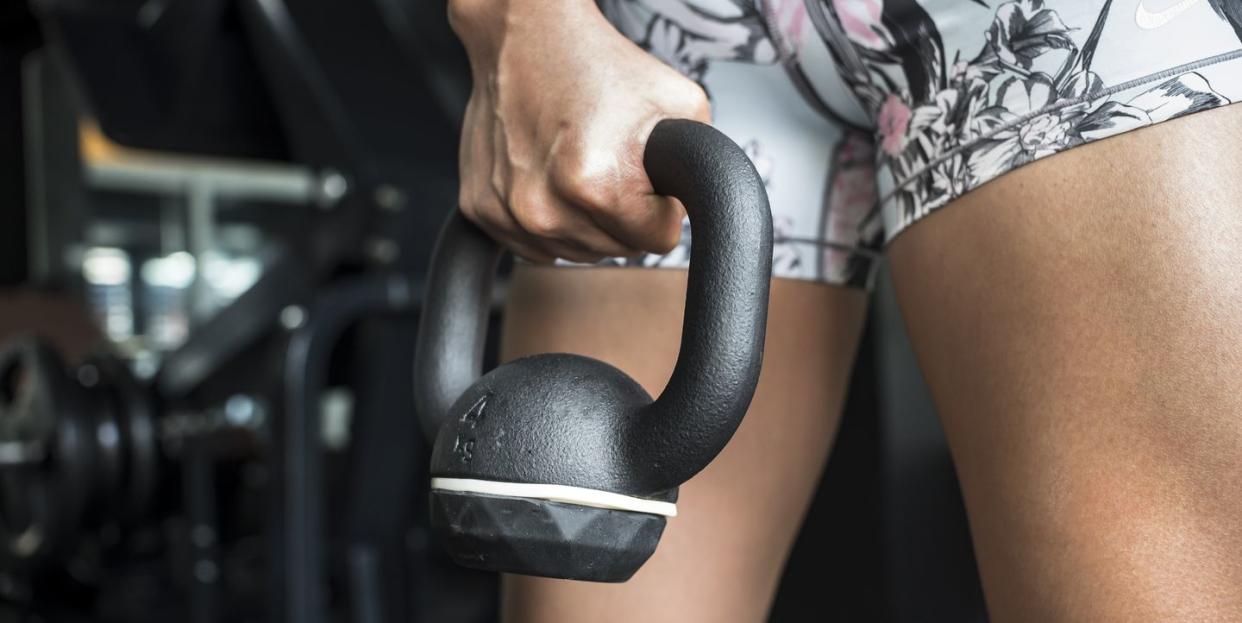Best grip strength exercises to do at home and the gym, ranked by effectiveness

Measly grip strength is one of the most common gripes when it comes to weightlifting. Think about it. How many times have you had to cut a deadlift set short because your hands are cramping up? Having good grip game isn’t all in the name of training, either. Carrying in your shopping bags from the car (kudos to anyone who can do more than five at once), picking up boxes, driving – they all require strong grip strength.
The reason you might struggle is that you don’t have ‘the capacity to hold or sustain your grip, or the strength needed in your fingers to maintain a crunch,’ so says strength and conditioning coach Andy Vincent. Workout-wise, this means you’ll have no choice but to wrap your reps up or, worst case, run the risk of injury.
Science backs this up: a study in the Journal of Strength & Conditioning Research found that hand grip strength is a good indicator of muscular strength and endurance, while another showed a correlation between poor grip strength and poor lateral rotator strength. Further research has shown that good grip strength is associated with a lower risk of cardiovascular disease, and another found that those with lower grip strength were more likely to be diabetic or have high blood pressure.
With all that in mind, read on to find out how to improve your grip strength, how to test your grip strength, and the best grip strength exercises, according to Vincent.
What is grip strength?
In a nutshell, grip strength is ‘your capacity to hold and sustain grip in your hand, or the overall strength of your fingers to crunch,’ Vincent explains. It’s about the amount of force or power you can create with your forearm and hand muscles (which we’ll break down in detail below), and it is these muscles that determine your level of grip strength.
Naturally, these muscles are trained less frequently (have you ever heard anyone saying they’re off to train their hands?), so this is why your grip strength is often the first thing to fail when weightlifting, and therefore the reason that you’re unable to lift as heavy, or perform as many reps.
What muscles make up your grip?
As mentioned, your grip strength is determined by both your hand and forearm muscles. Vincent breaks these down below.
Hand muscles:
Thenar
Hypothenar
Interossei
Lumbrical muscles
Forearm muscles:
Flexor digitorum superficialis
Flexor digitorum profondus
Flexor policus longus
6 benefits of good grip strength
There are plenty more, but for the purpose of this article, Vincent highlights the following as the main rewards to reap from improving and training your grip strength.
Better grip strength will mean you can lift heavier weights and become stronger
Better grip strength will improve your overall endurance, since you can do more reps and train for longer
Better grip strength will improve your performance in any hand sports
Better grip strength will make daily chores easier and more manageable, like lifting boxes, hoovering
Better grip strength will improve your cardio health and reduce risk of cardiovascular disease, as seen in the research above
Better grip strength will reduce your chances of elbow and wrist pain and overall injury
4 types of grip
When I first started weightlifting, my grip strength (or lack of) was clearly holding me back. Elite PT Loui Fazakerley explained that there are different types of grip that you can use, to help you train both the front and back muscles of your forearm and hands. Switching up your grip also means you can give the other muscles a break when they start to ‘give up’, without needing to stop your sets completely.
Vincent concurs that this is a good approach to improving and training your grip strength, advising that these are the four types of grip you could try:
Supinated grip: When both of your palms are facing forwards
Pronated grip: When both of your palms are facing backwards
Mixed grip: When one hand is pronated, and the other is supinated (you can mix these either way)
Hook grip: Where your thumb is under your four fingers. ‘This is an advanced grip, using in powerlifting and Olympic weightlifting,’ Vincent caveats.

These four types of grip can be used for both barbells and dumbbells.
How to test your grip strength
Still with us? When it comes to testing your grip strength, Vincent says there are a few ways you can do so.
Use a dynamometer (a handheld grip strength device).
These are pretty cheap, and you can buy them online, or you may find some hanging around your gym. To test your grip strength with one, perform three squeezes on each hand. How does that feel? If you struggled to ‘close’ the device (i.e. squeeze it until it’s completely shut), try two squeezes, and build up from there. Three squeezes too easy? Go until you reach your max.
2. Pinch grip strength test. ‘Hold two weight plates together in your fingers, and squeeze and hold them for as long as possible,’ says Vincent.
3. Dead hang test. ‘Hang from a pull-up bar for as long as possible,’ Vincent advises.
6 signs you could improve your grip strength
Answering yes to any of the below is a sign you could do with improving your grip strength. And good news: we can help you do just that. Stick with us.
You suffer from elbow or wrist pain
You can’t go heavier on certain lifts without using weightlifting straps
Your forearms burn out when lifting weights, or during other workouts like rowing or circuit classes
You get thumb cramp in hand sports
You struggle in day-to-day tasks, like carrying in shopping bags
Your hands get tired or cramp up when you use a keyboard for too long
How to improve grip strength at home
Now for the bit you’ve all been waiting for: how to increase your grip strength. You don’t necessarily need a gym membership and/or access to weights, as Vincent shares the following hacks to do at home.
Door dead hangs. ‘Find a door with a thick architrave and perform a dead hang on the wood.’ Hold for as long as possible, and repeat three times.
Shopping hold. ‘Load up some heavy-duty shopping bags with heavy household items, like bottles of detergent.’ Hold as many bags as you can in each hand at the same time for as long as possible, and repeat three times.
Bottle squeezes. ‘Fill up a bottle of water until it’s 75% full, then twist the lid on tight and squeeze with max effort for 10-30 seconds.’ Do 3-5 rounds per hand.
5 grip strength exercises, ranked from most to least preferred
Vincent says there are plenty of exercises you could do to improve your grip strength, but if he had to choose five, it would be these. He’s listed them in order of his preference, with dead hangs being his most preferred, and hammer curls being his least (but still very effective) preferred.
1.Dead hangs
How to: Using a secure overhead bar, grip the bar with an overhand grip (palms facing away from you). Move your feet off the step or bench so that you're hanging on to the bar. Keep your arms straight, and hang for as long as you can.
2. Farmer’s carry
How to: Holding a dumbbell in each hand, with your arms down by your sides, walk forward in a straight line without letting the weights bang against the side of your leg. Continue for 30 to 60 seconds. Rest for 30 to 60 seconds, then repeat. Do three to five sets.
3. Pinch grip carry
How to: Pinching the top of a weight plate in either hand, with your arms down by your sides, walk forward in a straight line without letting the weights bang against the side of your leg. Continue for 30 to 60 seconds. Rest for 30 to 60 seconds, then repeat. Do three to five sets.
4. Suitcase carry
How to: Holding a kettlebell in one hand, with your arms down by your sides, walk forward in a straight line without letting the weight bang against the side of your leg. Continue for 30 to 60 seconds. Rest for 30 to 60 seconds, then repeat with the weight in the opposite hand. Do three to five sets.
5. Hammer curl
How to: Stand with your feet hip-width apart, holding a pair of dumbbells at your sides. Palms should be facing inward, with your back straight and chest upright. Without moving your upper arms, bend your elbows and curl the weights toward your shoulders. Slowly lower the dumbbells back to starting position with control. That's one rep. Do three to four sets of 12 reps.
6 grip strength form tips
1.‘When using a barbell, position the bar across your palm, and not in your fingers, before closing your hand into a fist. The bar will undoubtedly slip during the set into your fingers, but it’s better to start with it in your palms’
2. ‘Keep your hands evenly spread out around the weights.’
3. ‘Your thumbs offer a lot of grip power; really accentuate wrapping them around your weights to ‘lock in’ your grip.’
4. ‘If you’re going for max effort when weightlifting, try the load with lifting straps first. Going for a PB when you’ve also got your grip to think about isn’t wise. Straps are a strategic way of helping you get comfortable with the lift, before losing them and calling upon your grip strength.’
5. ‘Use rest pauses when lifting. Do as many reps as you can, then put the weight down and pause for 20 seconds before continuing.’
6. ‘Practice mobility. Wrist ‘cars’ are my go-to mobility drill for your wrists and hands, and forearm stretches are great for tight forearms. To do wrist cars, get onto all fours and place your palms flat on the floor with your fingers facing in towards you. Then move your fingers so that they’re facing forwards, and then out to the sides. You can lean into the wrists to increase the stretch.’
You Might Also Like


